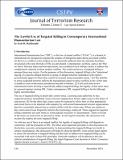Files in this item
The lawful use of targeted killing in contemporary international humanitarian law
Item metadata
| dc.contributor.author | MacDonald, Scott D. | |
| dc.date.accessioned | 2013-08-28T15:53:48Z | |
| dc.date.available | 2013-08-28T15:53:48Z | |
| dc.date.issued | 2011-11-11 | |
| dc.identifier.citation | MacDonald, S.D. (2011). The lawful use of targeted killing in contemporary international humanitarian law. Journal of Terrorism Research, 2(3), pp. 126-144. | en_US |
| dc.identifier.issn | 2049-7040 | en_US |
| dc.identifier.uri | http://ojs.st-andrews.ac.uk/index.php/jtr/article/view/232 | en_US |
| dc.identifier.uri | https://hdl.handle.net/10023/4018 | |
| dc.description.abstract | International humanitarian law (“IHL”), or the law of armed conflict (“LOAC”), is a branch of international law designed to regulate the conduct of belligerent states during an armed conflict. [1] However, conflicts in the modern era are drastically different than the interstate hostilities envisioned at the time the bulk of IHL was developed. Contemporary conflicts, such as the 'War on Terror' between states and non-state actors, have resulted in new military tactics to address the complications inherent in these modern conflicts. The controversial use of targeted killing is amongst these new tactics. For the purposes of this discussion, targeted killing is the “intentional slaying of a specific alleged terrorist or group of alleged terrorists undertaken with explicit governmental approval where they cannot be arrested using reasonable means.” [2] The inability to arrest suspected terrorists reflects the transnational aspect to these conflicts as the victim state is unable to exert enforcement jurisdiction beyond its borders. [3] Until such time as new international norms develop to specifically address targeted killing, the legality of this tactic must be assessed against existing IHL. Under contemporary IHL, targeted killing is lawful although highly circumscribed. | en_US |
| dc.language.iso | en | en_US |
| dc.publisher | Centre for the Study of Terrorism and Political Violence, University of St Andrews | en_US |
| dc.relation.ispartof | Journal of Terrorism Research | en_US |
| dc.rights | This is an open access article published in Journal of Terrorism Research. This work is licensed under a Creative Commons Attribution 3.0 License (http://creativecommons.org/licenses/by/3.0/) | en_US |
| dc.rights.uri | http://creativecommons.org/licenses/by/3.0/ | |
| dc.subject | Law | en_US |
| dc.subject.lcc | HV6431 | en_US |
| dc.subject.lcsh | Terrorism | en_US |
| dc.title | The lawful use of targeted killing in contemporary international humanitarian law | en_US |
| dc.type | Journal article | en_US |
| dc.description.version | https://doi.org/Publisher PDF | en_US |
| dc.publicationstatus | Published | en_US |
| dc.status | Peer reviewed | en_US |
| dc.identifier.doi | https://doi.org/http://doi.org/10.15664/jtr.232 | en |
This item appears in the following Collection(s)
Except where otherwise noted within the work, this item's licence for re-use is described as This is an open access article published in Journal of Terrorism Research. This work is licensed under a Creative Commons Attribution 3.0 License (http://creativecommons.org/licenses/by/3.0/)
Items in the St Andrews Research Repository are protected by copyright, with all rights reserved, unless otherwise indicated.


